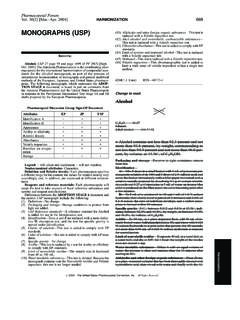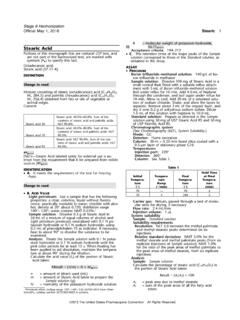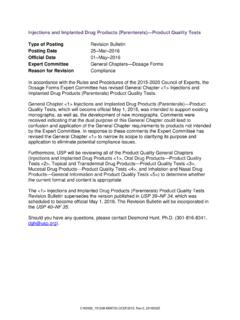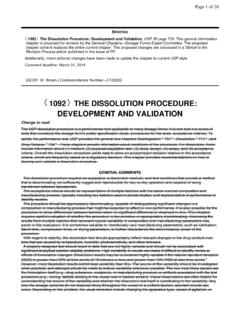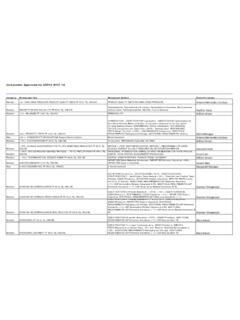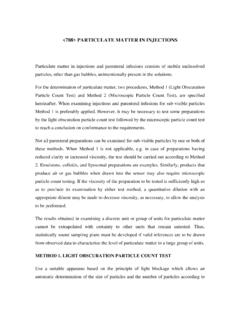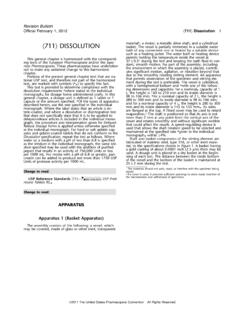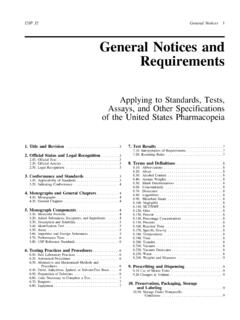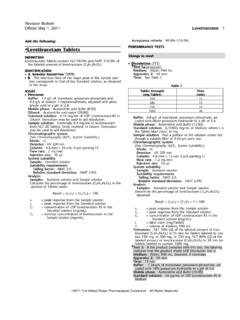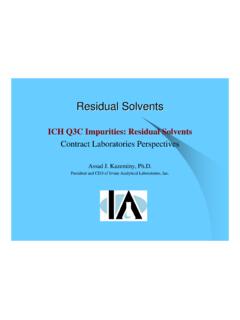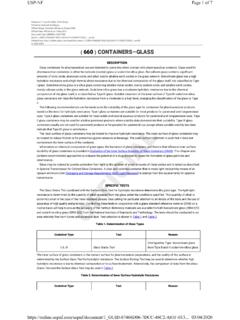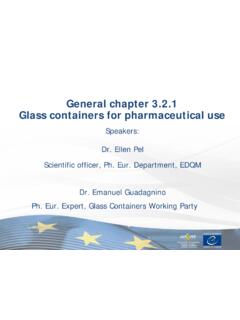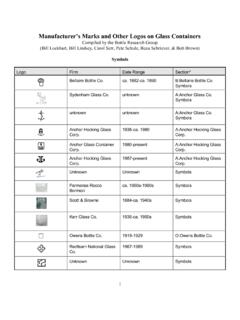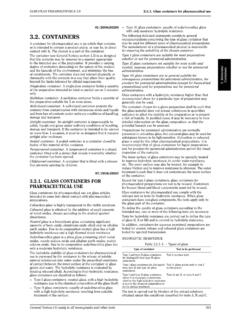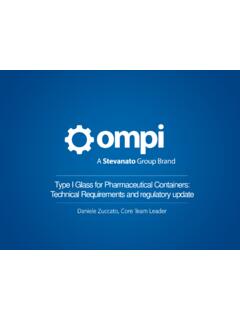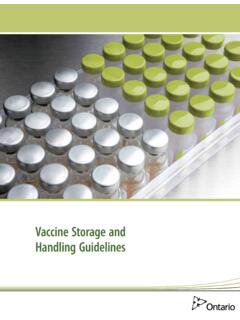Transcription of 1660 EVALUATION OF THE INNER SURFACE DURABILITY OF …
1 BRIEFING 1660 EVALUATION of the INNER SURFACE DURABILITY of glass Containers. In response to the recent product recalls that have further increased the pharmaceutical industry s heightened awareness of glass quality and glass delamination ( , the formation of glass flakes in a vial), USP proposes a new general information chapter to recommend approaches to predict potential formation of glass particles and delamination. (PSD: D. Hunt.) Correspondence Number C115672 Add the following: 1660 EVALUATION OF THE INNER SURFACE DURABILITY OF glass CONTAINERS PURPOSE This general information chapter provides information about factors that affect the DURABILITY of the INNER SURFACE of glass containers and recommends approaches to predict the potential of a drug product to cause formation of glass particles and delamination and to detect their occurrence. Useful procedures are listed and can be applied for both characterization and control tests.
2 SCOPE This chapter addresses molded bottles and vials manufactured by molding; or ampules, cartridges, vials, and prefillable syringes manufactured from tubing glass . glass for pharmaceutical packaging is classified as Type I borosilicate glass , Type II treated soda-lime-silica glass , or Type III soda-lime-silica glass on the basis of the hydrolytic resistance of the glass , as defined in Containers glass 660. Type I glass containers are suitable for most products for parenteral and nonparenteral use. Type II glass containers are suitable for most acidic and neutral aqueous products for parenteral and nonparenteral uses, and can be used for alkaline parenteral products when stability data demonstrate their suitability. Type III glass containers usually are not used for parenteral products or for powders for parenteral use, except when suitable stability test data indicate that Type III glass is satisfactory.
3 This chapter focuses primarily on Type I glass , because it is the most widely used in the biopharmaceutical industry. The chapter should be useful for the following: Contract manufacturing and filling organizations Molded and tubing glass container manufacturers and converters Pharmaceutical and biopharmaceutical companies glass , in the form of ampules, bottles, cartridges, vials, and prefillable syringes, is the Page 1 of 94/17/2012file://\\ \share\SHARE\USPNF\PRINTQ\pager\pdfs\ material of choice for parenteral products. This is especially true for the biopharmaceuticals that have increased the demand for small-volume glass cartridges, vials, and prefillable syringes. glass delamination, which ultimately results in the appearance of lamellae, is a serious quality issue and can result in a product recall. Delamination with the appearance of glass lamellae is a lagging indicator of structural instability.
4 Although delamination is the most obvious visual indicator, it represents the final stage of a seriously weakened glass SURFACE structure, and can be observed only at a point where prevention is no longer an option. In addition, mechanical energy from shaking or vial-to-vial contact may dislodge the lamellae from the weakened internal SURFACE . Tests for delamination combine an examination of the vial SURFACE and analysis of an aggressive test solution to predict the propensity of the internal glass SURFACE of vials to delaminate. Indicators include the appearance of a pitted, fractured SURFACE instead of a smooth SURFACE , as well as a number of changes in the test solution, including increases in SiO2 concentration, the ratio of SiO2/B2O3 or Si/Al, the number of subvisible particulates in the solution, and a fall in pH. glass TYPES glass in its pure form consists of silicon dioxide with a melting point of approximately 1700.
5 Added network modifiers, such as sodium and potassium oxides or boric oxide, lower the melting point, while other network stabilizers, such as calcium and aluminum oxides, improve the DURABILITY of the glass . Colored glass ( , amber glass ) is produced by transition metal oxides such as iron oxides. All additives to pure silicon dioxide can be viewed as potential extractables in glass . glass compositions do not exist at a stoichiometric chemical composition but rather are expressed over a range of compositions. Thus, there is allowable variation within a glass type, and glass types may vary slightly among glass producers. Soda-lime-silica glass consists of silica (60% 75%), sodium and potassium oxides (12% 18%), and smaller amounts of calcium, magnesium, and aluminum oxides (5% 12%). This glass has a relatively high coefficient of expansion (COE) of 10 5 per degree and is susceptible to damage by thermic shock.
6 Borosilicate glass consists of silica (70% 80%), boric oxide (7% 13%), and smaller amounts of sodium, potassium, and aluminum oxides. The presence of boron provides greater resistance to thermal shock and to hydrolytic attack. Type I glass is available in two formulations: 33 glass and 51 glass , in reference to their individual COEs of 10 7 per degree and 10 7 per degree, respectively. FORMATION OF MOLDED AND TUBING glass CONTAINERS Formation of molded and tubing glass containers requires a number of steps. The quality of the container used in packaging depends on the conditions and the quality control of each step. Both molded and tubing glasses originate from a glass furnace, and different furnaces are dedicated to borosilicate or soda-lime-silica glass . The refractory bricks lining the furnace deteriorate with time and must be replaced. Worn bricks can contribute to cosmetic defects such as stones (inclusions in the glass ) that become incorporated into the molded glass containers or glass tubing.
7 Molded glass vials and bottles are manufactured using a stream of molten glass cut to form a piece of glass that then enters a mold that shapes the container . Formation of containers from tubing glass is a two-step process. glass tubes of a specific diameter are formed from a stream of molten glass that exits the furnace, is cooled, and is sectioned into standard lengths. Page 2 of 94/17/2012file://\\ \share\SHARE\USPNF\PRINTQ\pager\pdfs\ tubes are subsequently converted into glass containers (ampules, cartridges, syringes, or vials) by either the glass manufacturer or by independent converters. It is technically difficult to form glass tubing with a diameter sufficient to make bottles containing 100 mL or more, so these containers are produced by molding. Gas flames are used to soften tubing glass to form the neck, to melt the glass to form the ampuls or vial base, and to separate the container from the glass tube.
8 In the case of cartridges and prefillable syringes, the glass tube is cut to length, and the ends are softened to form the nozzle and flange of the syringe and the neck and rear of the cartridge. Heating rate, maximum glass temperature, and production speed are critical parameters that can be adjusted for individual forming machines. After formation, both tubing and molded containers pass through an annealing oven (lehr) that heats the containers to approximately 570 and then gradually cools them in order to remove stresses in the container due to the manufacturing process. This too is a critical process because poorly annealed containers show reduced DURABILITY . The process of forming tubing vials and ampules has an effect on the local SURFACE composition of the glass . During formation of the neck and particularly the base, the temperature of the INNER SURFACE of the containers can exceed the evaporation point of some of the glass components such as alkali borates.
9 Under certain time temperature conditions, the glass can phase separate during forming, creating nonhomogenous SURFACE chemistry on the interior of the container . Both scenarios are undesirable for the storage of aggressive liquids from a SURFACE DURABILITY perspective. Evidence of this can be obtained by appropriately etching the glass with acid, after which an opaque ring will appear above the heel of the container , indicating a negative change in the INNER SURFACE chemistry. The same phenomenon can be observed at the shoulder of the container as well, but in many instances this area does not experience prolonged contact with a liquid. glass also is reheated during depyrogenation and sterilization, both before and after filling during terminal sterilization. The temperatures used for these steps are below those used for forming and annealing (see Table 1), and do not pose an additional risk to the DURABILITY of the glass from phase separation volatilization.
10 The chemical DURABILITY of the glass can also be compromised by the presence of water during these unit operations, because water can diffuse into the glass and disrupt the silicate structure. Table 1. Temperatures Encountered During Formation and Processing of Type I Tubing glass Containers At times, the INNER surfaces of glass ampules, vials, and bottles undergo additional treatments. As an example, heating glass propagates sodium oxide toward the INNER SURFACE of the container , but washing with water does not remove sodium oxide because of the latter s Key OperationsTypical Temperatures ( )Furnace1650 Sectioning of tube and base formation1370 Working range1000 1200 Softening827 Annealing570 Depyrogenation range250 350 Terminal sterilization121 Page 3 of 94/17/2012file://\\ \share\SHARE\USPNF\PRINTQ\pager\pdfs\ solubility. Over time, sodium ions migrate into the solution in the container and produce hydroxide ions, resulting in an elevated pH in unbuffered solutions.
